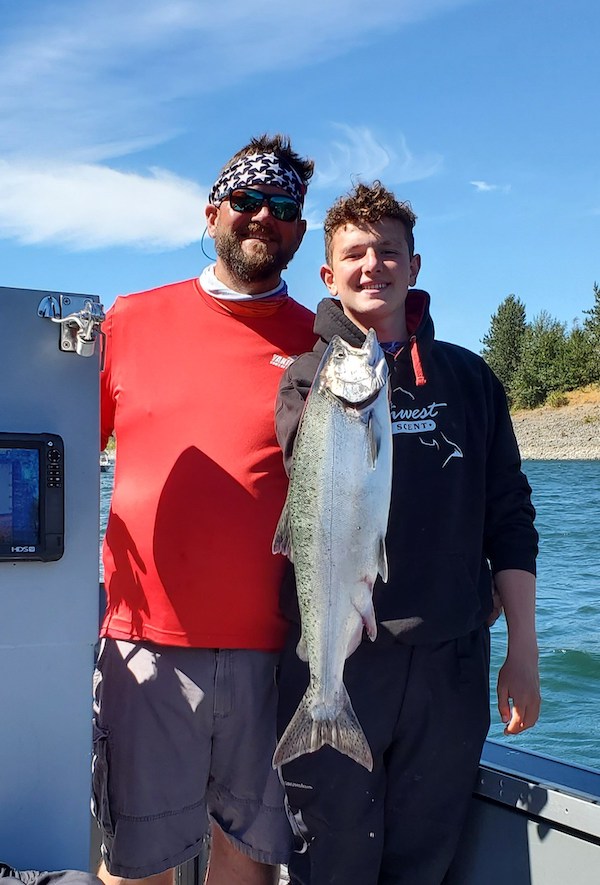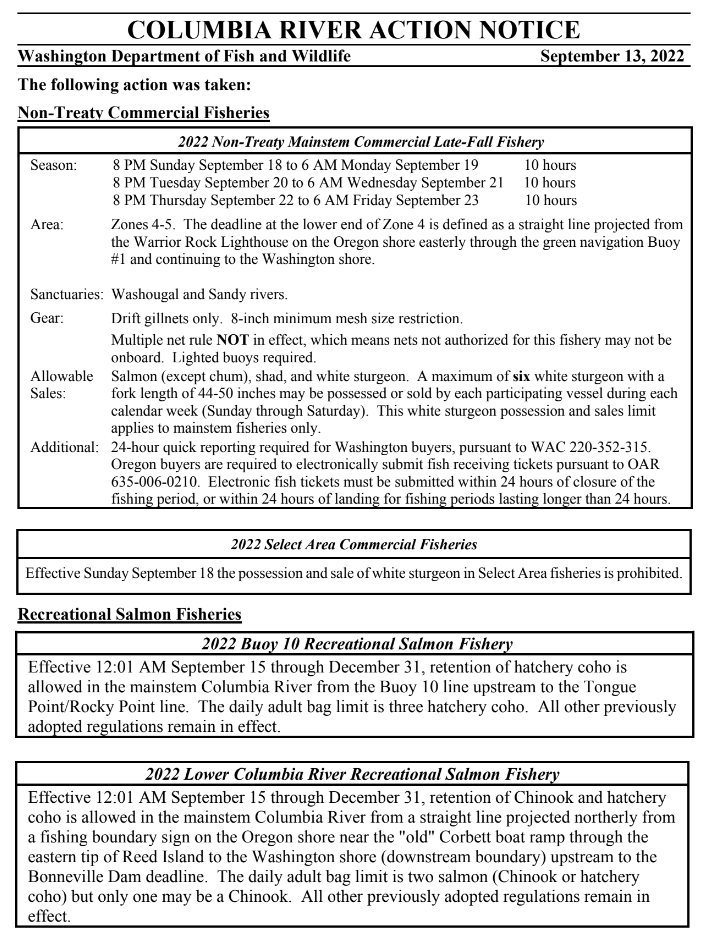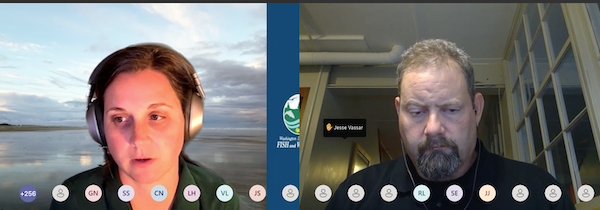
Parts Of Lower Columbia Reopen For Fall Chinook, Hatchery Coho
Salmon fishing will resume on portions of the Lower Columbia as Washington and Oregon managers loosened a closure that suddenly shut down angling for Chinook and coho on 144 miles of the big river two weeks ago.

Fishing will restart Thursday, September 15 for three hatchery silvers a day from Buoy 10 to the Tongue Point-Rocky Point Line just upstream of Astoria, and for fall Chinook and fin-clipped coho from the eastern end of Reed Island, which is between the Corbett exit on I-84 and Steigerwald NWR, to Bonneville Dam, daily limit two but only one king.
Managers were able to reopen salmon in those two sections because impacts on natural-origin tule Chinook during the back half of the month are expected to be minimal, based on past coded-wire tag recoveries in both zones, and there was still a bit of flexibility in the overall sport-commercial-tribal limit for the stock.
High catches of those wild tules, an ESA-listed fish, are the reason the river was closed to recreational angling as of September 2. Impacts went far beyond preseason expectations in August, primarily at Buoy 10 late in the month during the any-Chinook fishery, thanks to a very strong bite there.
While that is suggestive of a larger-than-predicted run with a longer “tail,” per se, a fact sheet out ahead of this afternoon’s meeting of the Columbia River Compact termed opening the top and bottom ends of the Lower Columbia later this week “a low-risk option.”

Salmon anglers should still find a lot of fish around too.
We are likely now drifting into the back half of the fall Chinook run – comprised mainly of upriver brights but also tules returning to gorge hatcheries – but recent counts at Bonneville have been running from 17,842 to 33,607 a day, while coho fishing yesterday off the mouth of the big river was “off the hook,” per a Northwest Sportsman source, who reported sorting through numerous wild silvers to find six keepers for their crew.
“Triples, doubles – over and over and over. There are a lot of coho still out there,” they stated.
Back in this afternoon’s well-attended meeting, guide Bob Rees asked state managers for fishing to be reopened at the buoy as early as tomorrow, if there was no jeopardy to tule impacts, reporting that coho are “staging” closer and closer to the mouth of the Columbia. Other guides noted that if the DFWs can shut a fishery down with less than a day’s notice, they can open one as well.
The fact sheet states that a late September Buoy 10 coho fishery is expected to touch less than 1,000 Chinook and equate to an impact of .02 percent on lower river wild tules.
The 13-day closure at the peak of the Lower Columbia fall salmon fishery had angered anglers, and while managers weren’t happy shutting it down either, last week ODFW’s Tucker Jones said it was “pretty impossible” to do anything about it having topped the impact limit by so much last month and with no way to update the wild tule runsize, unlike above-Bonneville returns.
Why Chinook fishing couldn’t have been opened in the western gorge earlier was initially puzzling. Per the fact sheet, over the past 20 years just one Lower Columbia hatchery tule – a surrogate stock to track wild tule impacts – has been caught there during the fall fishery and none in September.
Jones made a point to note that when the full fall fishery is all said and done, the nontreaty commercial fleet in the lower river will have used less than its full share of tule impacts, coming in around 85 percent, essentially mitigating for the sport overage at the buoy. His questioning of DFW staffers also fleshed out that the 2022 sport-comm ESA impact allocation balance will clock in at 75-25, a sore point for Oregon as Fish and Wildlife Commission guidance policy for the season was 70-30.

Anglers also asked for managers to extend fishing downriver from Reed Island, but that too was a no go.
“We’re pretty much pegged on the allowable impacts and we know these (staff-recommended) fisheries appear to fit within the allowable impacts. I don’t want to do things that don’t work,” said Jones.
“I’m right there with you,” agreed Dr. Charlene Hurst, WDFW’s counterpart for Columbia management.

The National Marine Fisheries Service’s Jeremy Jording, who though his agency doesn’t have a vote in the Columbia River Compact has been paying vocal attention to the fall salmon fishery this season, said he supported the DFWs’ staff recommendation to reopen angling.
Managers also approved three nontreaty commercial fishing periods in the Lower Columbia today.
As it stands, ODFW and WDFW report 77,000 angler trips yielded 28,862 Chinook kept and 21,949 released from Buoy 10 to the western end of Puget Island from August 1-September 1, racking up a tule impact rate of 6.68 percent versus the preseason expectation of 3.87 percent. The coho catch there tallied 7,632 kept and 4,557 released.
From Puget Island to Warrior Rock there were 3,617 Chinook kept and 221 released – .3 percent tule impact compared to an expectation of 1.4 percent – with 46 coho kept and 48 released.
And from Warrior to Bonneville, 1,092 Chinook were kept and 82 were released – 0 percent in effect vs. a forecast of 1.3 percent – along with zero coho bonked and two released.
Meanwhile, Stuart Ellis of the Columbia River Inter-Tribal Fish Commission reported that the 18,772 fall Chinook counted at Lower Granite Dam on the Snake through yesterday (10-year average is 10,239) was a record and the run could end up around or matching 2014’s record 60,687.
And Ellis said that while the coho run might not be as high as forecast, many of this year’s return are likely the result of tribal supplementation programs that have helped rebuild the species in the Columbia Basin.
THE FOLLOWING IS A PRESS RELEASE FROM THE OREGON DEPARTMENT OF FISH AND WILDLIFE
almon fishing will reopen at Buoy 10 and in the Gorge from Reed Island to Bonneville Dam beginning Sept. 15, fishery managers from Oregon and Washington decided today.
Buoy 10 anglers will be allowed to retain hatchery coho beginning Thursday, Sept. 15 with a daily bag limit of three hatchery coho.
Anglers will also be allowed to retain Chinook and hatchery coho in the lower Columbia between Reed Island and Bonneville Dam beginning Sept.15. The lower boundary for this fishery is defined as a line projected northerly from a fishing boundary sign near the “old” Corbett ramp through the eastern tip of Reed Island to the Washington shore.
Managers had closed all salmon fishing below Bonneville Dam on Sept. 2. Higher-than-expected catch, effort, and handle rates of lower Columbia River tule fall Chinook in the Buoy 10 fishery meant that the recreational fishery used more than its share of the allowed ESA impacts for this ESA-listed stock, which is the most constraining salmon stock this time of year. Because commercial fisheries had not used all their share of the allowed impacts, the recreational overage did not cause combined non-treaty fisheries to exceed ESA limits.
The reopening of the salmon fishery has been structured to minimize any further handle and impact to lower river Columbia River tule Chinook. The coho-directed fishery in the traditional Buoy 10 area (Buoy 10 line upstream to the Tongue Point/Rocky Point line) during late September will be expected to handle and release fewer than 1,000 Chinook, of which only 5-10 percent are expected to be tule Chinook. The Chinook directed fishery in the lower Columbia Gorge is not expected to accrue any additional LCR tule impacts and provides some additional fishing opportunity for anglers upriver. (By late September, most LCR tules will have moved above Tongue Point and do not travel as far upstream as Reed Island.)
The recreational fishery has used more than its share of ESA impacts (75 rather than 70 percent), but these fishing proposals are not expected to increase the disparity in the catch-sharing, since impacts to LCR fall Chinook will be minimal.
“Reopening the fisheries in this way allows us to provide recreational opportunity without further impacting commercial fisheries—which have had to curtail their opportunity to cover the sport overage—and does allow Buoy 10 anglers to target this year’s excellent and still building coho run,” said Tucker Jones, ODFW Columbia River Programs Manager. “I’m glad we could provide this opportunity without further impacting commercial fishing seasons.”
Fishery regulations are as follows:
Area: Buoy 10 line upstream to the Tongue Point/Rocky Point line
Season: Sept. 15-Dec. 31
Bag limit: 3 hatchery coho
Area: Mainstem Columbia River from a straight-line projected northerly from a fishing boundary sign on the Oregon shore near the “old” Corbett boat ramp through the eastern tip of Reed Island to the Washington shore (downstream boundary) upstream to the Bonneville Dam deadline
Season: Sept. 15-Dec. 31
Bag Limit: 2 salmon (Chinook or hatchery coho), only one of which may be a Chinook
All other regulations remain in effect.
Check for the latest fishing regulations by visiting ODFW’s Recreation Report – Fishing Report for your zone and clicking Regulation Updates https://myodfw.com/recreation-report/fishing-report/columbia-zone
THE FOLLOWING IS A PRESS RELEASE FROM THE WASHINGTON DEPARTMENT OF FISH AND WILDLIFE
OLYMPIA – The popular Buoy 10 fishery at the mouth of the Columbia River will reopen for hatchery coho salmon fishing beginning Sept. 15, while another section of the lower river will reopen for Chinook and hatchery coho on the same day, fishery managers from Washington and Oregon announced today.
The river was closed to recreational salmon fishing below Bonneville Dam in early September due to concern over impacts to lower Columbia River “tule” Chinook salmon, which are listed as threatened under the Endangered Species Act (ESA). Managers with the Washington Department of Fish and Wildlife (WDFW) and Oregon Department of Fish and Wildlife agreed that due to the migratory path and timing of these Chinook, some recreational fishing could resume with minimal additional impacts to ESA-listed fish.
“We believe this two-week closure accomplished its goal, which was to prevent any additional lower-river tule impacts to the recreational fishery,” said Ryan Lothrop, Columbia River fisheries manager with WDFW. “The coho run appears to still be coming in strong, and we hope anglers get out and take part in what should be some good fishing during the second half of September and into October.”
So far this fall, nearly 399,000 adult Chinook and 70,000 adult coho bound for the upper regions of the Columbia have passed over Bonneville Dam.
The section of the Columbia River from Buoy 10 to the Rocky Point/Tongue Point line will open for retention of hatchery coho beginning Thursday, Sept. 15, with an adult daily limit of three hatchery coho. Anglers must release all salmon and steelhead other than hatchery coho.
Also on Sept. 15, a section of river from the eastern tip of Reed Island to Bonneville Dam will open for retention of Chinook and hatchery coho, with an adult daily limit of two salmon, only one of which may be an adult Chinook. Anglers must release wild coho. To see all regulations and a map of the boundary line from the eastern tip of Reed Island, visit WDFW’s emergency fishing and shellfishing rules webpage.
The section of river from the Rocky Point/Tongue Point line to the East Reed Island boundary, including Camas Slough, remains closed to salmon fishing.
As always, anglers should be sure to check the 2022-23 Washington Sport Fishing Rules pamphlet to see permanent regulations for the section of river where they hope to fish, as well as WDFW’s emergency rules webpage for updates to this and other fisheries across the state.

